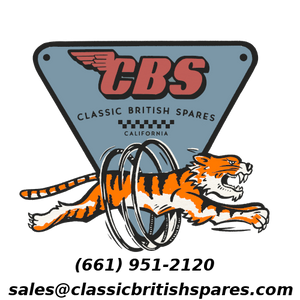
A Rare Piece Of Triumph Racing History
So what is this “rare piece of Triumph racing history” that we will be covering today?
Anyone want to take a guess?
What we have here is a rare piece of Triumph motorcycle racing history that has made its way from England, to Lancaster, Ca only 53 years later
Let’s take a look...
Triumph Racing History; Daytona 200 (1966-1967)

From 1966-1967 Triumph had 2 successful back-to-back racing wins at Daytona (Florida)
For 1966, Buddy Elmore was riding aboard a JOMO tuned Triumph T100R when he took home 1st place and for 1967, the following year, Gary Nixon got the #1 win aboard a Tri-Cor tuned Triumph T100R
Both Triumph wins put a stop to Harley-Davidson’s 3-year winning spree at Daytona
The dual Daytona wins did help the Triumph brand at the time which in turn led the “launch” for the new Triumph T100R “Daytona” production bike
The man behind the wins

Buddy Elmore and Gary Nixon were both very talented racers during their time period
However, if you look deeper, you will find a talented engineer in which helped them both win Daytona
The man behind the project was Doug Hele..
Doug Hele wanted to put Triumph on the “map”, which consisted of winning and competing
This idea of racing (winning) would help the Triumph name and sales which was being overshadowed by Honda and many of the Japanese motorcycle manufacturers during the 1960s
Not only a win, but to put a dent Harley-Davidson winning streak at Daytona
With Doug’s experience and design from Norton he was the perfect man to make Triumph, Triumphant
The race bikes

With Doug Hele in charge of the controls he only had 5 months to make a potent Triumph unit 500 that could compete with Harleys 750 flat head at the Daytona 200
A standard 500 unit twin machine rated at 32 BHP was “built” and “modified” by Doug and his engineers to achieve an impressive 52 BHP at 8,000 RPM
The benefits of using the Triumph unit 500 was the short stroke and the ability to make power at high RPMs
Not only where Doug’s 500s fast, they where also “one-offs” and highly modified; more so than any standard production 500
Modified frames, engines, oil tank, timing covers, cranks, Fontana drum brakes, heads, rocker boxes and wheels; not one single detail was overlooked or modified for racing
Each detail was done to achieve the 52 BHP
Ignition housing

Now that we have covered some brief racing history let’s talk about this “rare part”
This ignition unit was made by Lucas for both Triumph & BSA "racing" twins
Inside the hosing you will find dual bronze-cage ball bearings similar as to what you would find in a standard K2F Lucas magneto
Although this housing looks like a modified Lucas magneto, it’s not
Made from cast alloy then machined to spec, this piece here features the date stamping “68” for 1968

Further inside you will also find dual “6CA” style points with stiffer spring bands, solid advance shaft (no advance unit), blanchard ground points plate, wiring, output shaft and an oil seal
This ignition housing is the same unit that was fitted to Gary Nixon’s and Buddy Elmores winning Daytona bikes (as well as Percy Tait’s, and a few others)
The structure and overall design was to prevent ignition deflection at high Rpms according to Doug Hele inside his book “Triumph Experimental”
Although a “one off” piece for the Triumph race bikes, I could only assume a part like this would have cost a fortune to design, cast and machine for only a few bikes
How many of these ignitions actually survive?

With this piece potentially belonging to Doug Heles race bikes, it’s hard to imagine that this part actually exists
Not only is it a rare piece, it’s NOS, which means it was never fitted (or used) on any bike
This “clock-wise” ignition was unique for Doug’s race motors, in fact, without the special magnesium timing cover, this unit really cannot be used without some serious modifications to a stock timing cover
The male spade gear on the shaft was turned and driven by the exhaust cam with a special fitting
Final words

My gut feeling tells me that this housing was a spare for the race bikes or Lucas actually made a very small run for Triumph and sold-off the others
The 1968 date code on the housing makes me confident of my point above as the racing season Triumph entered was from 1966-1967, however some 1968 bikes that where raced where rumored to be 1967 machines..
I have seen this housing fitted on "replica" race bikes machines, so it’s very possible there could be more out there than what we believe
Although we will never find out the “true” history behind this one piece here, however it is interesting to think about all the different possibilities and hands it could of have been in
I hope you enjoyed this post
Thanks for reading
Like what you read? Click here to read more posts like the one above
Have something to say? - Feel free to leave us a comment in the section below
Ride safe!

Classic British Spares
@Boyd – Hey Boyd! I hope you are doing well! You bet, its sitting in my display case right now.. Thanks for reading, be safe!
Classic British Spares
@Kimo – Yes, would have been nice but $$$$$. Thanks for reading!
Classic British Spares
@Raymond – Yep you got it, lots of work on the 500’s… pretty trick machines
Classic British Spares
@Walter – Thank you! Yes I agree, so much work involved and it took lots of people to make it all come together
Stu Entwistle
Really very very interesting, thanks many more please.